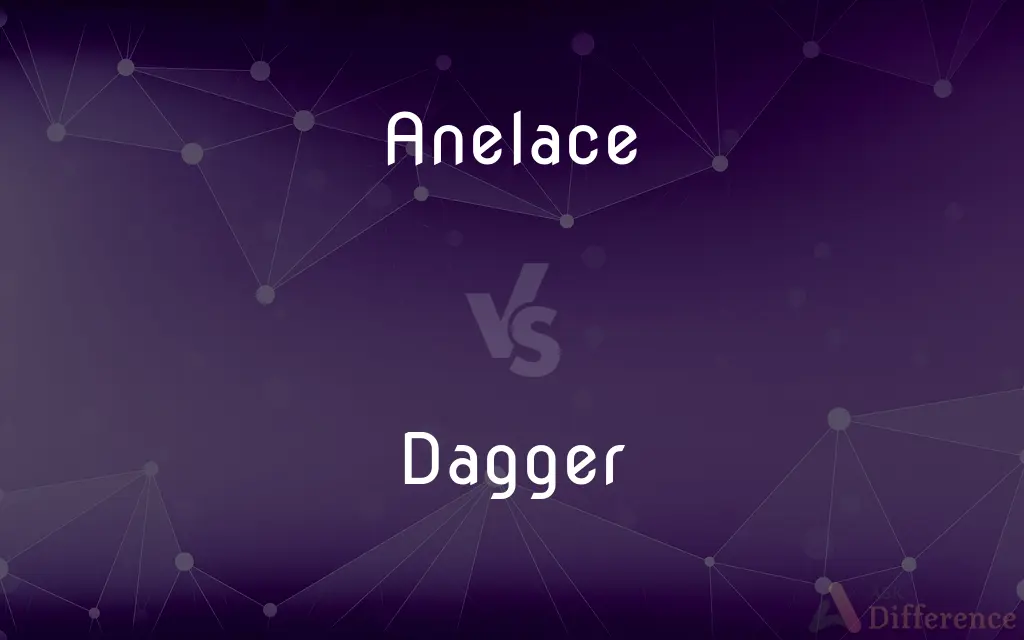Anelace vs. Dagger — What's the Difference?
Edited by Tayyaba Rehman — By Fiza Rafique — Updated on April 7, 2024
An anelace is a large, medieval dagger with a broad blade, often worn by civilians for self-defense, while a dagger is a small, pointed, double-edged knife used throughout history for close combat.

Difference Between Anelace and Dagger
Table of Contents
ADVERTISEMENT
Key Differences
An anelace, distinctive for its size and broad blade, was a popular weapon among civilians during the medieval period, serving both as a tool for self-defense and a status symbol. In contrast, a dagger is characterized by its sharp, pointed design and double edges, making it a versatile weapon for stabbing and thrusting in close combat situations. The dagger's historical use spans various cultures and epochs, emphasizing its role in personal defense and military engagements.
The anelace typically features a longer blade than most daggers, providing a reach advantage in combat scenarios. This attribute made it particularly effective for self-defense, as it could be used against opponents both unarmed and armored. On the other hand, daggers, with their compact size and pointed design, were favored for their ease of concealment and ability to inflict deep, lethal wounds, making them ideal for surprise attacks or as a secondary weapon in warfare.
One of the defining features of the anelace is its broad, often straight blade, which could be used for slashing as well as thrusting. This made it somewhat versatile in combat, despite its size. Daggers, however, with their narrower blade, are primarily designed for thrusting, although their edges are sharp enough for cutting. The focus on thrusting allows for precise strikes, aiming for gaps in an opponent's armor or targeting vital areas.
In terms of handling, the anelace was often equipped with a simple cross-guard and might feature a rounded or slightly tapered grip, designed to accommodate the use of gloves or gauntlets. This contrasts with the dagger, which has evolved to include a variety of hilt designs tailored to specific fighting styles and periods, from the ornate hilts of Renaissance Italy to the more functional grips of military daggers used in modern times.
The anelace is less recognized today, primarily remembered by medieval enthusiasts and historians for its role in civilian defense and as part of the civilian attire. Daggers, however, have maintained a symbolic presence in many cultures, often representing bravery, stealth, or treachery, depending on the context. They continue to appear in ceremonial roles and as part of military regalia, signifying their enduring relevance.
ADVERTISEMENT
Comparison Chart
Size
Large with a broad blade
Smaller, more compact
Primary Use
Self-defense, civilian weapon
Close combat, military and personal defense
Blade Design
Broad and often straight
Narrow, pointed, double-edged
Combat Style
Slashing and thrusting
Primarily thrusting, some cutting
Cultural Significance
Historical, mainly medieval era
Widespread, varies by culture and epoch
Compare with Definitions
Anelace
Often dual-wielded or paired with another weapon.
In the duel, he brandished his sword and anelace, ready for any attack.
Dagger
Symbolizes stealth and courage.
The dagger tattooed on his arm symbolized his past as a fighter.
Anelace
A large medieval dagger with a broad blade, used for self-defense.
The merchant wore an anelace at his belt, a common practice for protection during travel.
Dagger
A small, pointed, double-edged knife used for stabbing.
The assassin's tool of choice was a sharp dagger, hidden within his cloak.
Anelace
Favored for its effectiveness against lightly armored foes.
The anelace was particularly useful in urban conflicts, where heavy armor was rare.
Dagger
Essential in close combat scenarios.
Trapped in close quarters, she relied on her dagger to defend herself.
Anelace
Symbolized a civilian's readiness to defend.
The anelace, prominently displayed, signified his status and willingness to fight if necessary.
Dagger
Evolved into various forms and designs over time.
The museum's collection included daggers from every continent, showcasing their global significance.
Anelace
Part of medieval civilian attire.
At the fair, he wore a historically accurate costume, complete with an anelace at his side.
Dagger
Used ceremonially in modern contexts.
At the graduation, the cadets were awarded ceremonial daggers as a symbol of their commitment.
Anelace
An anelace (or in Middle English anelas) was a medieval dagger worn as a gentleman's accoutrement in 14th century England. Frederick William Fairholt (1846) describes it as "a knife or dagger worn at the girdle", and George Russell French (1869) as "a large dagger, or a short sword, [that] appears to have been worn, suspended by a ring from the girdle, almost exclusively by civilians".Anelaces had a broad blade "sharp on both edges, and became narrower from hilt to point".
Dagger
A dagger is a knife with a very sharp point and usually two sharp edges, typically designed or capable of being used as a thrusting or stabbing weapon. Daggers have been used throughout human history for close combat confrontations, and many cultures have used adorned daggers in ritual and ceremonial contexts.
Anelace
(historical) A medieval long dagger.
Dagger
A short knife with a pointed and edged blade, used as a weapon
He drew his dagger and stabbed the leader
Anelace
Same as Anlace.
Dagger
A moth with a dark dagger-shaped marking on the forewing.
Dagger
A short pointed weapon with sharp edges.
Dagger
Something that agonizes, torments, or wounds.
Dagger
See obelisk.
Dagger
A double dagger.
Dagger
(weapons) A stabbing weapon, similar to a sword but with a short, double-edged blade.
Dagger
(typography) The text character †; the obelus.
Dagger
A point scored near the end of the game (clutch time) to take or increase the scorer's team lead, so that they are likely to win.
Curry's last-minute 3-point dagger silenced the criticism for his so-called failure to come up big in big moments.
Dagger
A timber placed diagonally in a ship's frame.
Dagger
To pierce with a dagger; to stab.
Dagger
A short weapon used for stabbing. This is the general term: cf. Poniard, Stiletto, Bowie knife, Dirk, Misericorde, Anlace.
Dagger
A mark of reference in the form of a dagger [
Dagger
A timber placed diagonally in a ship's frame.
Dagger
To pierce with a dagger; to stab.
Dagger
A short knife with a pointed blade used for piercing or stabbing
Dagger
A character used in printing to indicate a cross reference or footnote
Common Curiosities
Why were daggers so widely used across different cultures?
Daggers were accessible, easy to conceal, and effective in close combat, making them universally valuable across various cultures and time periods.
How has the perception of daggers changed over time?
Initially practical weapons, daggers have evolved to symbolize various concepts like bravery, stealth, or betrayal in literature and modern culture, while also serving ceremonial purposes.
Were anelaces used in military contexts?
Anelaces were primarily civilian weapons for self-defense and were not commonly used in formal military engagements.
What makes an anelace different from a traditional dagger?
The anelace is larger, with a broader blade, making it more suited for slashing, whereas traditional daggers are compact and designed primarily for stabbing.
Is there a specific way to wield an anelace effectively?
The anelace was typically used in a manner similar to other large daggers, with an emphasis on both slashing and thrusting, depending on the opponent's armor.
Were anelaces ever used as tools, or strictly as weapons?
Primarily weapons, anelaces could also serve utilitarian purposes, similar to how small knives are used today.
Can anelaces be considered a type of sword?
While larger than typical daggers, anelaces are not classified as swords due to their size and intended use; they occupy a middle ground, used mainly for self-defense by civilians.
Do any modern military forces still use daggers?
While not for combat, daggers often appear in modern military forces as part of ceremonial dress or as symbols of achievement.
What is the historical significance of daggers in espionage?
Daggers have been historically associated with espionage due to their ease of concealment and lethality, ideal for covert operations.
How did one carry an anelace?
Anelaces were typically worn at the belt, easily accessible for self-defense or as a display of social status.
Share Your Discovery

Previous Comparison
Buffalo vs. Bull
Next Comparison
Anthropology vs. PsychologyAuthor Spotlight
Written by
Fiza RafiqueFiza Rafique is a skilled content writer at AskDifference.com, where she meticulously refines and enhances written pieces. Drawing from her vast editorial expertise, Fiza ensures clarity, accuracy, and precision in every article. Passionate about language, she continually seeks to elevate the quality of content for readers worldwide.
Edited by
Tayyaba RehmanTayyaba Rehman is a distinguished writer, currently serving as a primary contributor to askdifference.com. As a researcher in semantics and etymology, Tayyaba's passion for the complexity of languages and their distinctions has found a perfect home on the platform. Tayyaba delves into the intricacies of language, distinguishing between commonly confused words and phrases, thereby providing clarity for readers worldwide.
















































